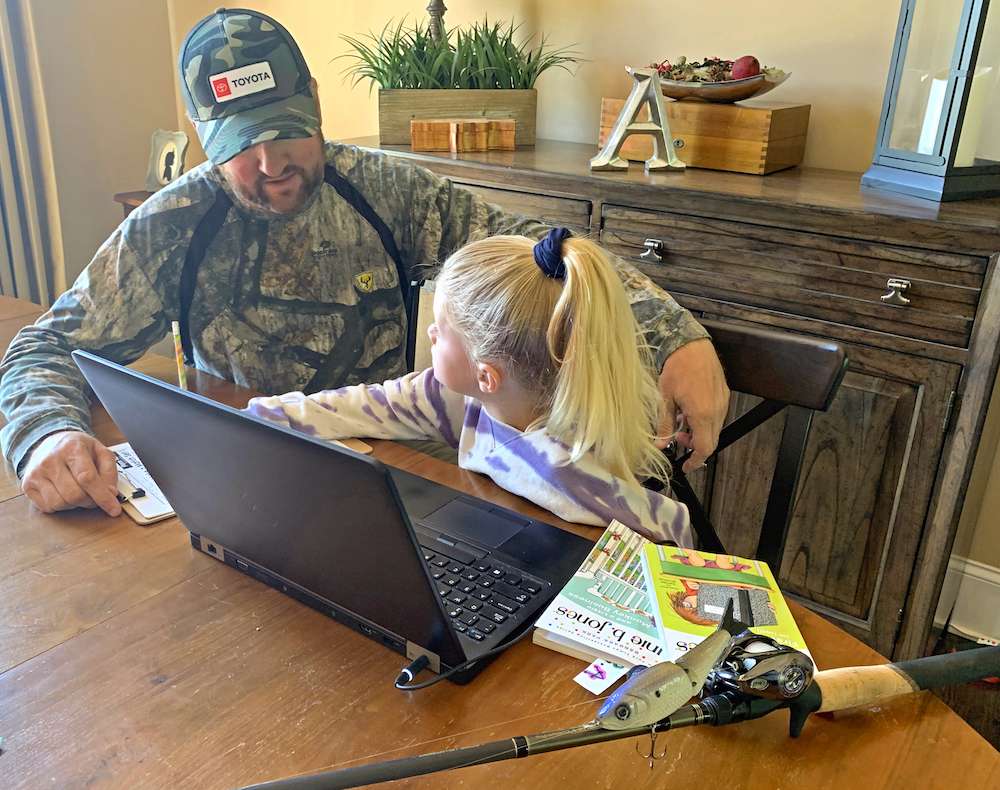
When he’s not on the road competing as a Bassmaster Elite Series pro, a phone call with Team Toyota’s Matt Arey can cover a wide range of topics, and young daughters Reese and Wren can often be heard in the background.
Arey often plays the role of “Mr. Mom” to his two blonde-headed girls, while sweet wife Emily fulfills her full-time career obligations as Director of Records and Educational Partnerships at Cleveland Community College near their Shelby, N.C., home. But now, under COVID-19 virus stay-at-home orders, he’s added “distance learning” instructor for 7-year-old Reese to his daily obligations.
“I have to be honest, when I first started teaching her I got frustrated a fair amount, and it really tried my patience. I had to learn to slow down and be really repetitive,” admits Arey, who earned a degree in agriculture business and economics from N.C. State.
Things are going just fine now. In fact, on the morning of our call, Arey had already successfully covered a reading comprehension worksheet, math fractions and an adjective project in which Reese had to use various words to describe bubble gum.
Away from the makeshift in-home classroom, Arey has tested his patience in the turkey woods, as well as trying to perfect his skills with the relatively new category of lures referred to as glide baits.
Extremely realistic looking in their highly detailed design, glide baits are hard baits with a single mid-body hinge that allows them to swim with a very lazy “wide S” motion to tempt aggressive bass. They typically range from 4 to 12 inches long and cost anywhere from $35 to $235 each. Arey often favors throwing a 6.5-inch version called the Hog Father Jr. on 20-pound P Line fluorocarbon.
“A glide bait is definitely a specialized bait that’s probably not going to get you 40 bites a day, but the bass that commit to eating it are generally bigger fish,” says Arey.
Weather and water conditions have to line up well to precipitate glide bait success. For Arey that includes fairly clear water that allows big bass to see the lure, but also wind and sunshine to increase visibility and mask their shyness.
“Glide baits are a great bait for drawing strikes from big female bass suspended around boat docks either right before the spawn, or seeking their first good meal right after the spawn. But you have to exercise a lot of patience until you catch your first bass of the day on a glide bait, as well as patience to carry you through to that second bite of the day. But again, the bites you get are going to be good ones,” he says.
Few outdoor adventures teach patience more so than turkey hunting, but Arey has proven himself savvy on four successful hunts this spring. He shot one in North Carolina, one in South Carolina, called one in for a buddy and his most rewarding time in the turkey woods was calling one in for daughter Reese.
“Turkeys are born paranoid, and they die paranoid, because their whole life is spent avoiding their many predators. So walking into the woods, sitting next to a tree, calling a few times and killing one only happens about 10% of the time,” he says.
Arey says for starters you need an in-depth understanding of the terrain you’re hunting because that dictates a gobbler’s potential travel path to your call. He also warns that too many hunters try to “take their call to the gobbler” by walking closer to where they believe the bird to be, rather than waiting on the bird to come to them.
“Let the gobbler work. Let him do his thing. Don’t over call, and don’t get in a game of chase with him. Have patience and make the gobbler come to you,” he says.
From bubble gum based adjective lessons with daughter Reese, to luring gobblers over a ridge top and big fat bass from under docks on glide baits – patience is indeed the central fiber to success in Matt Arey’s life these days.

